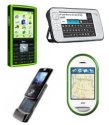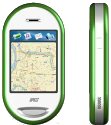Linux phone market opening up?
Jan 9, 2007 — by LinuxDevices Staff — from the LinuxDevices Archive — 1 views [Updated Jan. 12, 2007] — Four vendors are helping change Linux-based phones from voice-focused appliances into multimedia computers, writes Sascha Segan of PC Magazine. OpenMoko, TrollTech, Nokia, and Motorola are using open source to cut costs, add flexibility, and/or attract community and commercial developers, Segan suggests.
[Updated Jan. 12, 2007] — Four vendors are helping change Linux-based phones from voice-focused appliances into multimedia computers, writes Sascha Segan of PC Magazine. OpenMoko, TrollTech, Nokia, and Motorola are using open source to cut costs, add flexibility, and/or attract community and commercial developers, Segan suggests.
OpenMoko and the FIC Neo1973
 FIC Neo1973 (Click to enlarge) |
OpenMoko, a community project sponsored by Taiwanese computer manufacturing giant First International Computer (FIC), is working on a fully open-source Linux phone stack for the $350 FIC Neo1973 (pictured above), a GPS-equipped handset hardware design expected to ship this quarter. The Neo1973's hardware platform is produced in volume and marketed in China, equipped with a Windows Mobile OS. The phone is expected to become the first U.S. model to sport a full VGA (640 x 480) display.
The $350 Neo1973 will also be the first widely available phone with user-serviceable, open-source firmware — a feature that FIC hopes will inspire open source developers to port thousands of applications to the device. OpenMoko project founder Sean Moss-Pultz says about 3,500 applications are candidates for the platform, and that he is actively working to attract community developers to the OpenMoko project.
Trolltech Greenphone
 Trolltech Greenphone (Click to enlarge) |
Another open phone designed to attract developers is Trolltech's Greenphone, which was unveiled at LinuxWorld in August and began shipping in September.
Priced at $1,000, the Greenphone is not for consumers, but rather ISVs (independent software vendors), mobile phone integrators, and carriers/operators. By offering developers a physical rather than an emulated target, Greenphone aims to simplify application development, integration, and testing, for users of Trolltech's dual-licensed, Linux-based Qtopia Phone Edition stack and Greensuite complete software reference design.
A hands-on “developer's eye view” of building applications on the Greenphone can be found here.
Nokia's Maemo.org project
 Nokia N800 (Click to enlarge) |
Nokia, meanwhile, founded and sponsors the Maemo.org project that maintains firmware for its 770 and newly available N800 Internet tablets. Maemo's notable successes include attracting key desktop application developers to mobile development, and helping to “convert key desktop programming libraries such as glibc to the mobile platform,” Segan writes. Both OpenMoko and Trolltech credit Nokia for its pioneering efforts with regard to open, community-based device software development, according to Segan.
Segan quotes Ari Jaaksi, head of Nokia's open source software operations, as saying that he hopes to increase Nokia's involvement in the open-source community, both taking and giving back code. The day may come when OpenMoko's developers end up contributing code to applications for a Nokia tablet, Jaaksi reportedly said.
More of Jaaksi's views and strategic insights can be found in his recent essay on “building consumer products with open source,” here at LinuxDevices.com.
Motorola's first Linux-based phone for the U.S.
 The MotoRizr Z6 (Click to enlarge) |
Finally, OpenMoko, Trolltech, and Nokia are all looking to Motorola to “raise the profile of Linux on phones,” Segan writes.
Motorola certainly did that on Valentine's Day, 2003, when it first announced its Linux phone strategy, and again in November of last year, when it announced that it would produce more phones based on Linux/Java. Then, yesterday at CES, it announced its first actual Linux phone likely to see widespread U.S. distribution — the MotoRizr Z6, a slider-style Linux/Java music phone that is expected to ship in the first half of 2007.
Additionally, Motorola announced a 2.75 G “Edge” upgrade to its popular Ming or a1200 smartphone, a svelte, touchscreen-based model said to be the best-selling smartphone in China.
Jennifer Lyons, marcom specialist for mobile devices, stated, “We've sold over six million handsets based on Linux to-date, and the MOTOMING is the #1 selling smartphone in China.”
Despite its use of Linux as an inexpensive operating system, the PC Magazine story suggests that Motorola has kept its user interface frameworks, phone applications, and in some cases even its Linux kernel modules proprietary. If only Motorola were to open up its Linux-based phones to Linux application developers, everyone in the Linux phone community — including Motorola — would certainly gain, Segan quotes OpenMoko's Moss-Pultz as having said.
On the other hand, Motorola did join Eclipse.org this summer, where it is spear-heading a “Tools for Mobile Linux” (tML) project that, as of November, 2006, was working to define requirements . Lyons stated, “Progress is being made here, but as you can imagine, developing this API to meet the needs of developers as well as carrier requirements is going to take some time.”
Lyons also notes that Motorola launched an open source community website last summer.
Access/PalmSource, too
Also of possible interest, though not mentioned in Segan's report, is Access/PalmSource, which in the course of developing its commercial Linux phone stack, has released several interesting open source applications along the way. The most interest of these is the Hiker framework released in the waning days of the 2006 calendar year.
Segan's complete, interesting article on the growing openness of the Linux phone market is available here.
This article was originally published on LinuxDevices.com and has been donated to the open source community by QuinStreet Inc. Please visit LinuxToday.com for up-to-date news and articles about Linux and open source.